We may not have the course you’re looking for. If you enquire or give us a call on +44 1344 203 999 and speak to our training experts, we may still be able to help with your training requirements.
We ensure quality, budget-alignment, and timely delivery by our expert instructors.
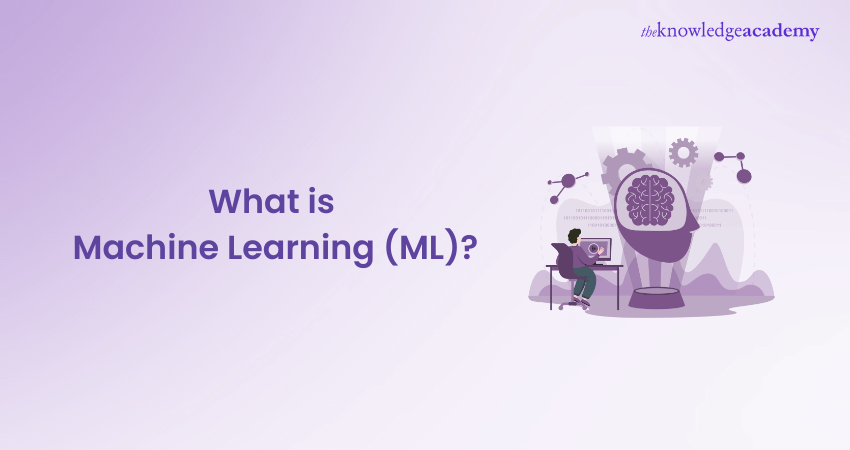
The idea of machines thinking and learning like humans is an exciting (and often unnerving) idea, which is what the groundbreaking field of Machine Learning (ML) explores. However, delving into What is Machine Learning is not just about learning its technological aspects; the philosophical implications it raises are just as monumental. In today's world, as a dynamic branch of Artificial Intelligence, ML powers everything from Netflix recommendations and self-driving cars to our shopping decisions.
This blog takes a deep dive into What is Machine Learning, spotlighting everything from its inner workings and types to its innovative applications and ethical implications. So read on and gain deeper insight into the tech that's reshaping our present and future!
Table of Contents
1)What is Machine Learning?
2) How does Machine Learning Work?
3) Machine Learning Versus Deep Learning Versus Neural Networks
4) Types of Machine Learning
5) Machine Learning Tools
6) Applications of Machine Learning
7) Benefits of Machine Learning
8) Challenges of Machine Learning
9) Scope of Machine Learning
10) Conclusion
What is Machine Learning
Machine Learning is a cutting-edge discipline within artificial intelligence that has transformed various industries and continues to shape the future of technology. Machine Learning is a process of designing algorithms that enable computers to learn and enhance their performance without explicit Programming by analysing data.
The driving force behind this advancement is the ability to analyse vast datasets, recognise patterns, and make precise predictions or decisions based on that knowledge. The primary motive of Machine Learning is to create models that can generalise well and make predictions or take actions on new, unseen data. There are several key approaches in Machine Learning, including supervised, unsupervised, and reinforcement learning.
Machine Learning has an extensive range of applications in various fields, including computer vision, recommendation systems, natural language processing, finance, healthcare, and many more. Machine Learning Skills play a crucial role in enabling innovations like virtual assistants, self-driving cars, and personalised content recommendations, transforming the way we interact with technology and the world.
How Does Machine Learning Work?
Here are four points on how Machine Learning works:
Data Preprocessing and Feature Engineering:
Machine Learning starts with data, and the quality and relevance of data are crucial. Before training a model, data preprocessing is performed to clean, normalise, and transform the data into a suitable format. Feature engineering is another critical step, where relevant attributes or features are selected and engineered to effectively enhance the model's ability to recognise patterns. The quality of features can impact the model's performance substantially, making this step vital in the Machine-Learning pipeline.
Model Selection and Training:
Choosing an appropriate model architecture is essential, as different algorithms are suited for various types of tasks. It’s also helpful to understand the difference between RPA and Machine Learning, as RPA typically focuses on task automation through rule-based systems, whereas Machine Learning leverages data-driven models to make predictions and decisions. Popular Machine Learning models include neural networks, support vector machines, Decision Trees, and many more. During training, the model adjusts its internal parameters iteratively using optimisation techniques such as Gradient Descent in Machine Learning to minimise the difference between actual labels and the predicted outputs. The process aims to find an optimal configuration that best captures data patterns.
Validation and Evaluation:
To ensure the model's reliability and avoid overfitting (where the model memorises the training data but fails to generalise), the model is validated and evaluated on a separate dataset called the validation set. This set was not used during training and acted as an unseen dataset to gauge the model's performance. Criteria such as accuracy, precision, recall, and F1 score are used to evaluate the model's effectiveness, helping to fine-tune hyperparameters and optimise its performance.
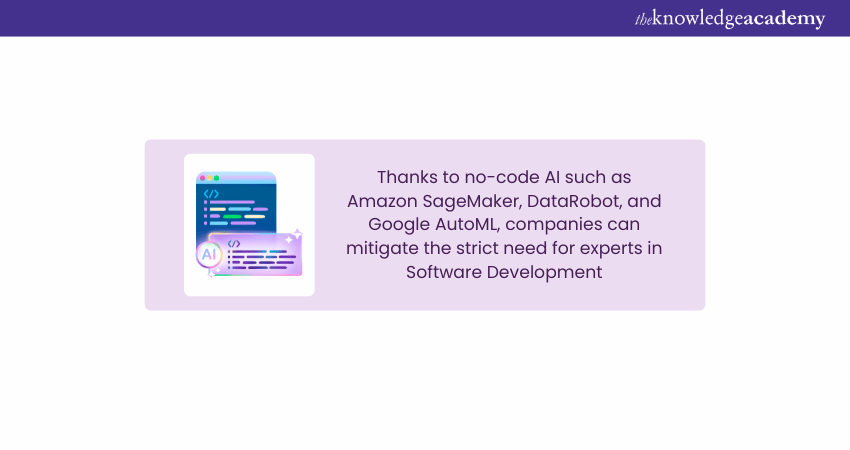
Deployment and Monitoring:
Once a satisfactory model is achieved, you can deploy it across real-world applications to make decisions or predictions. However, the process does not end here. Models require continuous monitoring during production to ensure they maintain accuracy and adapt to transforming data patterns. As new data becomes available, the model may require periodic retraining to remain up-to-date and relevant.
Improve your skill set to develop and train intelligent machines; sign up for Artificial Intelligence & Machine Learning Training now!
Machine Learning Versus Deep Learning Versus Neural Networks
The following table summarises the distinctions between Machine Learning, Deep Learning and Neural Networks:
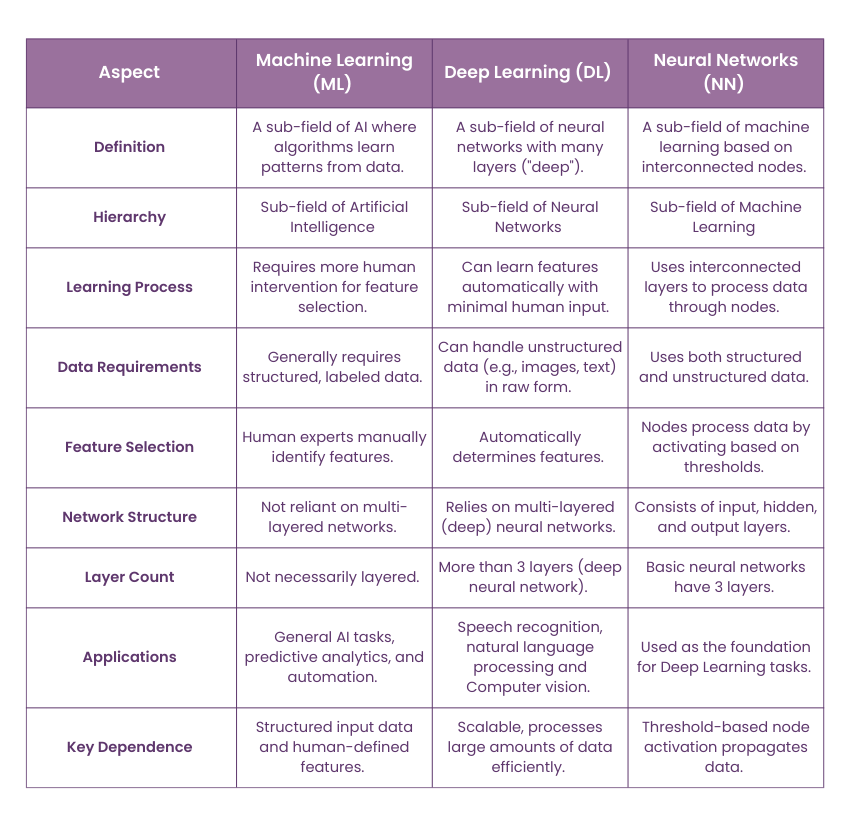
Stay prepared with the best Machine Learning Interview Questions for your next interview.
Types of Machine Learning
There are three main types of Machine Learning, each classified based on their learning approach: supervised, unsupervised, and reinforcement learning.
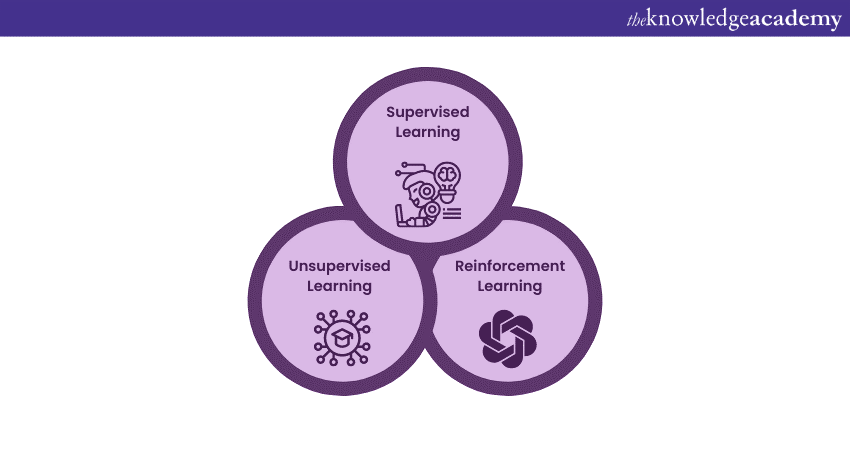
Supervised Learning
Supervised Learning is among the most frequently used categories of Machine Learning. It involves training models through labelled data, where every input is paired with its corresponding output. The algorithm learns from these examples and generalises them to make accurate predictions on new, unseen data.
Supervised learning is widely used in tasks like classification, regression, and natural language processing. It is beneficial when a significant amount of labelled data is available for training and when the goal is to map inputs to specific outputs.
Unsupervised Learning
Unsupervised learning operates on unlabelled data, meaning the algorithm receives no explicit guidance or predefined outputs during training. Instead, it seeks to find underlying patterns, structures, or relationships within the data.
Clustering, where data points are grouped based around similarities, and dimensionality reduction, which simplifies data representation while preserving its essential characteristics, are common applications of unsupervised learning. This type of learning is valuable when unstructured or unlabelled data are abundant and discovering meaningful insights or hidden patterns is the primary objective.
Reinforcement Learning
Reinforcement learning is a special approach where an agent masters the ability to make decisions by engaging with its surroundings. The agent takes action and receives feedback in the form of penalties or rewards, enabling it to adopt the most optimal strategy to achieve a particular goal.
Reinforcement learning is widely used in scenarios involving sequential decision-making, such as game-playing, Robotics, and autonomous vehicles. It is particularly effective when there is a need to train agents to adapt and learn in dynamic and changing environments.
Learn how to innovate and add values to project lifecycle phases in our comprehensive Artificial Intelligence (AI) For Project Managers Course - Sign up now!
Machine Learning Tools
Having the right tools in Machine Learning is as essential as understanding the associated concepts. These Machine Learning Tools, including Programming Languages and libraries, provide the building blocks for implementing and deploying Machine Learning algorithms. Let's explore the most popular of these tools:

Python for Machine Learning
Python is a popular language for ML owing to its simplicity and readability, making it an excellent choice for beginners. Additionally, it has a strong ecosystem of libraries tailored to Machine Learning. Libraries like NumPy and Pandas are used for Data Analysis and manipulation, while Matplotlib is used for data visualisation.
Python remains the dominant language in this field, but it’s worth emphasising its versatility across fields with libraries such as:
a) LangChain for building language model-based applications.
b) Hugging Face Transformers for natural language processing and Generative AI
R for Machine Learning
R is another language used in Machine Learning, especially for statistical analysis. It has a rich ecosystem of packages making it easy to implement ML algorithms. Packages such as caret, mlr, and randomForest offer a variety of algorithms, from regression and classification to dimensionality reduction and clustering.
TensorFlow
This is an open-source library for numerical computation, well-suited for large-scale Machine Learning. The Google Brain team developed it, and it supports both CPUs and GPUs. TensorFlow enables you to build and train complex neural networks, making it a go-to option for Deep Learning Applications. In the debate of PyTorch vs TensorFlow, TensorFlow’s extensive ecosystem and scalability make it a popular choice for industry applications.
Scikit-learn
This Python library provides a broad range of ML algorithms for supervised and unsupervised learning. It's known for its detailed documentation and clear API. Scikit-learn is primarily used for data analysis and data mining, and it integrates well with other Python libraries like Pandas and NumPy.
Keras
This is a neural network API written in Python. It can run on top of CNTK, TensorFlow, or Theano. It was designed with a focus on enabling fast experimentation. Keras offers a user-friendly interface for developing and training neural networks, which makes it the ideal choice for beginners in Deep Learning.
PyTorch
It's an open-source ML library based on the Torch library. It's known for its efficiency and flexibility, making it a good choice for researchers. PyTorch supports various applications, from natural language processing to computer vision. One of its exciting features is the dynamic computational graph, which enables flexible and optimised computation.
Applications of Machine Learning
Machine Learning has found many applications across various industries, including Spatial Data Science, revolutionising how we interact with technology and enhancing decision-making processes. Here are a few:
Personalisation and Recommendation Systems
Machine Learning has transformed how businesses interact with customers by enabling personalised experiences. E-commerce platforms employ recommendation systems to suggest products based on user browsing history and preferences which helps increase customer engagement and sales.
Streaming services leverage Machine Learning algorithms to recommend movies, shows, or songs that align with users' interests, leading to higher user retention and satisfaction. Personalisation also extends to content delivery on social media, where algorithms curate newsfeeds based on individual preferences and behaviours.

Healthcare and Medical Diagnosis
The healthcare industry has experienced significant improvements with the development of Machine Learning, especially in providing precise and prompt diagnoses, which are critical for patient care. Image recognition algorithms analyse medical scans like X-rays, MRIs, and CT scans to detect anomalies and assist radiologists in identifying diseases.
Machine Learning models can accurately predict the chances of patient readmissions, helping healthcare providers effectively allocate resources. Moreover, personalised medicine and genomics benefit from Machine Learning's ability to analyse large genomic data. This facilitates targeted treatments and drug development.
Predictive Maintenance and Manufacturing Optimisation
Machine Learning is vital in optimising production processes and enhancing efficiency in the manufacturing sector. Predictive maintenance leverages data from sensors and IoT devices to anticipate equipment failures before they occur, reducing downtime and maintenance costs.
Manufacturers also use Machine Learning for quality control, inspecting products in real-time to identify defects and deviations from desired specifications. These applications increase productivity, reduce waste, and improve overall manufacturing processes.
Understand the significance of Deep Learning and how it works, sign up for Deep Learning Course now!
Benefits of Machine Learning
Machine Learning offers numerous benefits that continue to revolutionise industries and elevate many aspects of daily life. Let's explore some of the biggest advantages of this revolutionary technology:
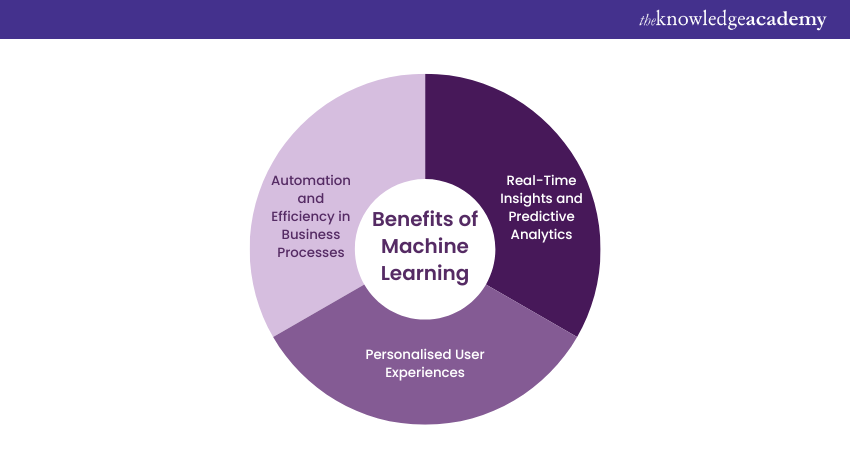
Real-Time Insights and Predictive Analytics
The capability of Machine Learning to process and analyse large volumes of data allows companies to gain valuable insights and make prompt decisions based on data. Predictive analytics, a crucial aspect of Machine Learning, empowers businesses to anticipate future trends, customer behaviour, and market dynamics
This foresight helps companies identify potential risks and opportunities, optimise Inventory Management, and tailor marketing strategies for higher returns on investment. By harnessing predictive analytics, businesses can stay competitive and proactively adapt to changing market conditions.
Personalised User Experiences
Machine Learning drives personalised user experiences across various platforms. E-commerce websites leverage recommendation systems to suggest products based on users' previous purchases and browsing history, increasing the likelihood of conversions. Streaming services utilise Machine Learning algorithms to curate personalised content playlists, keeping users engaged and satisfied.
Social media platforms employ Machine Learning to deliver tailored content to users, fostering higher user engagement and longer session times. Personalisation enhances user satisfaction and strengthens customer loyalty and retention, resulting in increased revenue and brand loyalty.
Automation and Efficiency in Business Processes
Machine Learning's automation capabilities streamline business processes, by reducing human error and manual intervention. Tasks such as customer support, document classification and data entry can be automated using chatbots and natural language processing. Employing automation can help to save time and resources while enabling employees to concentrate on more creative and strategic tasks.
Machine Learning also facilitates automated anomaly detection in various scenarios, such as network security and fraud detection. By identifying and flagging unusual patterns, Machine Learning helps businesses prevent potential threats and mitigate risks effectively.
Challenges of Machine Learning
Machine learning technology has made our lives easier as it continues to grow. However, implementing it in businesses has also raised several ethical concerns about AI technologies like ChatGPT and DeepSeek. Some of these include:
Technological Singularity
While there's public concern about this topic, many researchers are not worried about AI surpassing human intelligence in the foreseeable future. Technological singularity is also referred to as superintelligence or strong AI. Even though superintelligence is hardly imminent, the idea raises some interesting questions as we consider using autonomous systems, like self-driving cars.
If a driverless car causes an accident, then who's responsible and liable for it? Should we still develop autonomous vehicles or limit this technology to semi-autonomous cars that help people drive safely? Such ethical debates keep popping up as new, innovative AI technology develops.
AI Impact on Jobs
With every new disruptive technology, the demand for specific job roles shifts. Artificial intelligence will shift job demands to various other areas. There will be an increasing need for individuals to help manage AI systems. The human workforce will always be there to address complex problems within the industries affected by job demand shifts. The biggest challenge with AI and its effect on the job market will be helping people transition to new roles in demand.
Privacy
Privacy in the context of AI is often framed around data privacy, data protection, and data security. These issues have driven significant advancements in policy in recent years. For example, the General Data Protection Regulation (GDPR) safeguards personal data within the EU, empowering individuals with greater control over their information.
Such legislation has compelled organisations leveraging AI to reevaluate how they manage and process personally identifiable information (PII). Consequently, investments in strong security measures have become a critical priority, as businesses aim to prevent risks such as surveillance, Cyber Security Attacks, and misuse of AI-powered systems.
Bias and Discrimination
Instances of bias and discrimination across several Machine Learning systems have raised ethical questions regarding the use of AI. These questions are centred on safeguarding against bias and discrimination when biased human processes may generate the training data itself? While companies have good intentions for their automation efforts, incorporating AI into hiring practices can have unforeseen consequences.
Amazon unintentionally discriminated against job candidates for technical roles based on gender, and the company had to scrap the project in the end. Moreover, bias and discrimination aren’t limited to the HR function; they can be found in several applications, from social media algorithms to facial recognition software, as highlighted in the HR Functions Guide.
Accountability
Since no significant legislation regulates AI practices, there is no fundamental enforcement mechanism to ensure that ethical AI is practised. The current incentives prompting companies to be ethical are basically the negative repercussions of an unethical AI system on the bottom line. To fill that gap, ethical frameworks have emerged as a collaboration between researchers and ethicists to govern the creation and distribution of different Types of AI Models within society.
Scope of Machine Learning
The scope of Machine Learning is far-reaching and vast, including the following:
1) In Healthcare, Machine Learning promises more accurate disease diagnoses, enables personalised treatment plans and facilitates drug discovery.
2) In the Financial sector, ML optimises investment strategies, improves fraud detection and automates Credit Risk assessment
3) In the field of autonomous systems, ML is fuelling advancements in self-driving cars, drones, and robotics and enhancing navigation and environmental interaction.
4) In Natural Language Processing (NLP), ML is powering language translation, sentiment analysis and improving voice recognition technologies.
5) In the field of Marketing and Customer Service, ML enables personalised recommendations, supports chatbots for improved user engagement and Applies sentiment analysis to improve user experiences.
Conclusion
In conclusion, Machine Learning is a revolutionary force shaping how we work, live, and innovate. Machine Learning has unlocked limitless possibilities across industries by equipping systems with the ability to learn from data and improve accordingly. Understanding the difference between Deep Learning and Machine Learning is vital, as it helps define their respective roles in the technological landscape. As outlined in this blog, understanding What is Machine Learning is about exploring its potential and affirming that it's not just the future of technology; it’s the driving force behind it.
Dive into the world of Machine Learning? Sign up for Machine Learning Training now!
Frequently Asked Questions
What is the Difference Between AI and ML?

Artificial Intelligence (AI) is a broader concept involving the creation of systems that simulate human intelligence. On the other hand, Machine Learning is a subset of AI enabling machines to learn from data and improve performance without explicit programming.
What is an Example of Machine Learning?

Speech and image recognition and traffic alerts using Google Map are popular examples of Machine Learning.
What are the Other Resources and Offers Provided by The Knowledge Academy?

The Knowledge Academy takes global learning to new heights, offering over 3,000 online courses across 490+ locations in 190+ countries. This expansive reach ensures accessibility and convenience for learners worldwide.
Alongside our diverse Online Course Catalogue, encompassing 19 major categories, we go the extra mile by providing a plethora of free educational Online Resources like News updates, Blogs, videos, webinars, and interview questions. Tailoring learning experiences further, professionals can maximise value with customisable Course Bundles of TKA.
What is The Knowledge Pass, and How Does it Work?

The Knowledge Academy’s Knowledge Pass, a prepaid voucher, adds another layer of flexibility, allowing course bookings over a 12-month period. Join us on a journey where education knows no bounds.
What are the Related Courses and Blogs Provided by The Knowledge Academy?

The Knowledge Academy offers Artificial Intelligence & Machine Learning Training, including the Introduction to Artificial Intelligence Course and the Deep Learning with TensorFlow Course. These courses cater to different skill levels, providing comprehensive insights into the Goals of Artificial Intelligence.
Our Data, Analytics & AI Blogs cover a range of topics related to Machine Learning, offering valuable resources, best practices, and industry insights. Whether you are a beginner or looking to advance your Machine Learning skills, The Knowledge Academy's diverse courses and informative blogs have got you covered.
Upcoming Data, Analytics & AI Resources Batches & Dates
Date
 Machine Learning Course
Machine Learning Course
Fri 16th May 2025
Fri 18th Jul 2025
Fri 19th Sep 2025
Fri 21st Nov 2025






 Top Rated Course
Top Rated Course



 If you wish to make any changes to your course, please
If you wish to make any changes to your course, please


